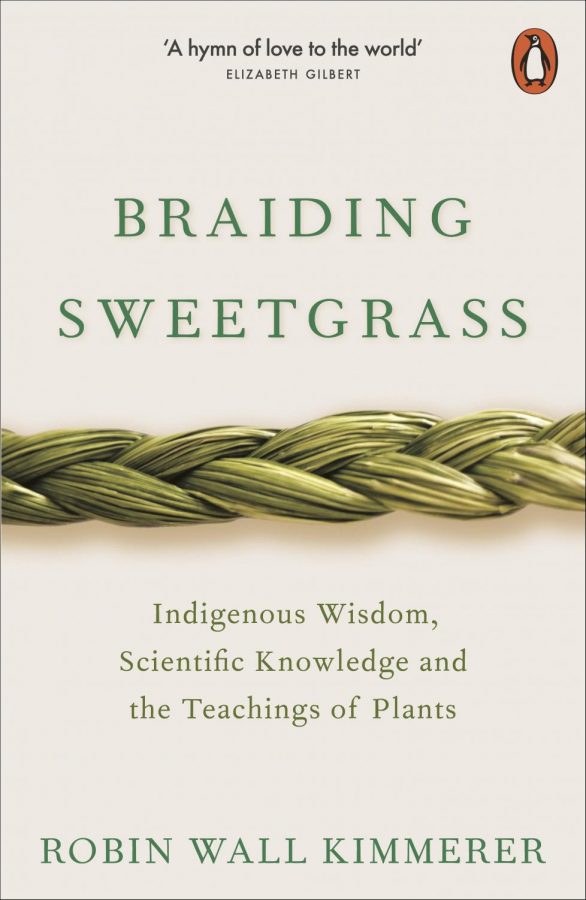“Braiding Sweetgrass” Sparks Conversation on Sustainability and Indigenous Tradition
NATIVE LIFE AND BIOLOGY: The panel discussion on “Braiding Sweetgrass” explored the Native legends and sustainability.
Students and faculty alike filed into the ALANA Cultural Center for an Environmental Studies Brown Bag on Friday, Nov. 12 to discuss the class of 2025 first-year reading, “Braiding Sweetgrass” by Robin Wall Kimmerer. The event featured an interdisciplinary panel including Professor of Biology and Environmental Studies Catherine Cardelús, Director of Sustainability John Pumilio and Lisa Latocha, Oneida Indian Nation member and Community Liaison.
Each of the panelists shared their personal take on the importance of the text to open the event. For Cardelús, this meant a guide to the softer side of her study of biology; for Pumilio this meant a reminder of the joy and optimism that brought him to study environmental sustainability in the first place; and for Latocha, this meant recognizing and celebrating the native teachings she has always known but has seldom heard told back to her. Latocha delivered a recitation in her native tongue, Onyota’a:ká:, welcoming everyone to the discussion and, more significantly, to the ancestral lands on which Colgate sits.
Over the course of the panel, participants engaged in discussion about the many themes of “Braiding Sweetgrass,” including reciprocity, the sharing of gifts and the link between scientific knowledge and indigenous ways of knowing.
For Pumilio, “Braiding Sweetgrass” served as a reminder of the beauty of the natural world and a renewed source of inspiration for his efforts to sustain it.
“When I first entered the field of sustainability, I entered with a sense of fascination and wonderment at the natural world. However, between global warming, deforestation and water pollution, it’s become all too easy to focus solely on the negatives. Reading [‘Braiding Sweetgrass’] has reminded me that there is so much more to sustainability than that and has rekindled some of the joy that got me into this field in the first place,” Pumilio said.
Cardelús also gained inspiration and insight from the book, aiding her in her study of biology at Colgate.
“Again and again, I found myself asking, ‘How is it possible that I don’t know these stories?’ The way that [Kimmerer] softens and humanizes the plants, eliminating the borders between scientific knowledge and human understanding is simply brilliant. As someone of a scientific background, it is so important for me to recognize these stories and further open myself to the biological world,” Cardelús said.
For a significant part of the discussion, panelists focused on the indigenous legend of The Three Sisters as retold in “Braiding Sweetgrass.” According to legend, there was once a harsh winter in which many native village people went hungry. Then, one snowy night, three beautiful sisters appeared in the village and asked for shelter. Despite the village people’s dwindling food and kindling, they welcomed the sisters with open arms and shared with them what little they had left. In gratitude, the three sisters revealed themselves as the powerful spirits of corn, beans and squash, and gave themselves to the people so that they could be fed throughout that winter and all the winters to come.
Since then, the three plants have been harvested together, with each sister contributing something vital to the other sisters’ crop. As they grow, the eldest sister, corn, offers the beans the necessary support to spread far and wide. In return, the middle sister, beans, pulls life-giving nitrogen from the air and delivers it to the soil so that all three sisters may flourish. Lastly, the youngest sister, squash, sits low to the ground and spreads her great leaves across the Earth to protect her sisters and ensure their continued growth.
Following the recounting of this legend, Latocha shared that in her own life, she feels a deep sense of connection to the independent and free-spirited beans who dare to climb for the benefit of all, and to the squash who sacrifices itself to protect its kin. As Latocha sees it, she and the beans and squash share the same gifts; she concluded her retelling by inviting the audience to consider the commonalities they may share with the three sisters in their own lives.
“What is your gift?” Latocha asked. “Not what you want to do in college or what you want to pursue as a future career, but what is your gift deep inside? The gift that you are born with and cannot help but share with the world.”
With this question lingering in the air, the panel transitioned to a brief discussion of the steps that community members can take to lead more sustainable lives, including wearing reusable masks and utilizing reusable water bottles, straws and Tupperware.
Excitingly enough, much of the audience already seemed well aware of these steps towards sustainability: as the panel concluded and attendees flocked towards the food table (graciously catered by Hamilton Whole Foods), there was a clamor as Tupperware was retrieved from backpacks to pack up sandwiches for later, and thermoses were unscrewed and filled with water.
In the words of Latocha: “Change what you can, and you can change everything,”







